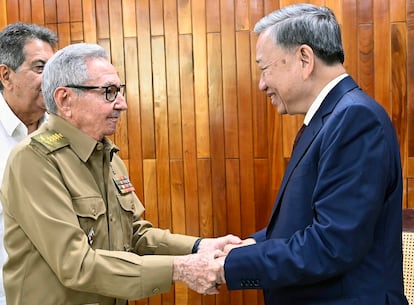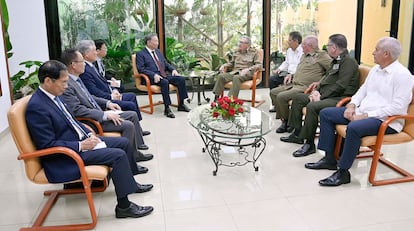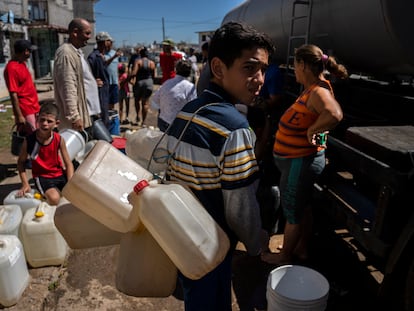Raúl Castro is still alive: The Cuban government’s strategy to defuse speculation about his health
Authorities paraded Fidel’s brother alongside the Vietnamese president during a recent visit to disprove rumors that the 93-year-old historic leader is dead

Raúl Castro is still alive. The Cuban government has made this clear by showing a photograph of him a few days ago amidst constant rumors announcing his death. It had seemed strange that Castro, accustomed to receiving ministers and senior leaders in Havana, was not present on the first day of the visit by the president of Vietnam, To Lam, who was instead welcomed by the Cuban president, Miguel Díaz-Canel, and his wife. It would seem normal for the president of a nation to deal with this type of event by himself, but the truth is that in Cuba, the figure and the surname Castro continue to pull the strings of diplomacy and power in the country, at least symbolically.
Not having seen Castro during the formalities of To Lam’s visit, many Cubans began to wonder what had happened to the former president, who unofficial sources have repeatedly stated is in a delicate state of health. More than once, social media have filled up with posts speculating about his death. Perhaps, as the Cuban citizen Lisbet Tase says, because “that is what ordinary Cubans expect the most.”
The Cuban government never made an official statement to openly rule out Raúl Castro’s death, or to confirm whether it is true that he suffers from some kind of illness, something that would not be unusual at his 93 years of age — his birthday was on June 3. But all this is nothing new: deep secrecy has always guarded Cuban leaders, their lives, their partners and their health conditions.
What the government has done is to bring Castro’s figure into the public light when several news articles falsely announced his death. The day after the Vietnamese leader’s visit, the historic Cuban leader was seen in a photo shared by the Cuban presidency, in which Castro appeared holding To Lam’s hands. The message was clear: Castro is still alive. Nor is this strategy new: when Fidel Castro’s death was imminent, and news of his passing were spread more than once, the government denied them all with a public appearance. The day that his death became a reality, no one predicted it. It was his own brother who took the microphone and very solemnly announced that Fidel had passed away at the age of 90.

The last public appearance by the youngest of the Castro brothers occurred just a few days ago, when images of the funeral for General and First Deputy Minister of the Army Corps Ramón Espinosa Martín were televised. Looking diminished, his lips tight and his olive-green uniform stiffly wrapped around him, he re-emerged together with some of the individuals who form part of the upper echelon of power amid wreaths of flowers and martial parades to honor the deceased.
For some time now, Castro has had to say goodbye to several of the historical leaders of the Revolution. It seems to be the end of a historical cycle, the end of an era: more than 60 years ago, that generation began to occupy positions of power in the country with the nascent Revolution and now, as Cuba struggles through the worst crisis in its entire history, time is forcing them out of their posts. In September, five people within the high spheres of power died, all of whom were over 80 years old, which shows that change in Cuba only comes from natural causes. In addition to Espinosa Martín (85), Raúl bid farewell to at least five more leaders, almost all his contemporaries: Romárico Vidal Sotomayor García, Juan Antonio Hernández Hernández, Jorge Luis Guerrero Almaguer, Juan Israel Cervantes Tablada and Leonardo Ramón Andollo Valdés. In the longest-serving government in the Western Hemisphere, Ramiro Valdés Menéndez, 92, still holds positions of power; so do José Ramón Machado Ventura, 93, and Guillermo García Frías, 96.
At other times, the Cuban government does not bring up Raúl’s figure to deny an alleged death, but to give a much-needed boost to President Díaz-Canel, a leader with very little charisma who has had to deal with an economic crisis, a coronavirus pandemic, a drop in tourism, natural disasters, massive and unprecedented protests and the largest migratory exodus in the country’s history. When Cubans took to the streets like never before on July 11, 2021, Castro, without any official positions in the government — in 2018 he stepped down as President of the Council of State and Cabinet of the Republic of Cuba and in 2021 he quit his position as First Secretary of the Communist Party — attended a public celebration and the closing of an event of the Central Committee of the Party. And, as if in an effort to keep alive the traditions that have recently lost traction with many Cubans, in January Raúl marched alongside other top leaders in the customary March of the Torches, held on the day before the birthdate of Jose Martí, Cuba’s national hero.
Also at the beginning of the year, in the midst of the economic debacle and the decision-making process to address the crisis in the country, Castro made a public appearance asking leaders who “are not up to the task that the moment demands” to resign from their posts. Castro has been in the news at the polls during elections, as a message to those in Cuba who have given up on the democratic exercise of voting. When Nicolás Maduro proclaimed himself the president of Venezuela in July despite well-founded suspicions of fraud, it was Raúl Castro who made a conspiratorial call to Caracas to congratulate him.
In all these appearances, he has been shown as an active figure who is aware of the issues in domestic and foreign politics. Above all, the government has tried to reassert the message that Castroism has not died, that it did not die with Fidel and that it would not even die if the last Castro dies.
Sign up for our weekly newsletter to get more English-language news coverage from EL PAÍS USA Edition
Tu suscripción se está usando en otro dispositivo
¿Quieres añadir otro usuario a tu suscripción?
Si continúas leyendo en este dispositivo, no se podrá leer en el otro.
FlechaTu suscripción se está usando en otro dispositivo y solo puedes acceder a EL PAÍS desde un dispositivo a la vez.
Si quieres compartir tu cuenta, cambia tu suscripción a la modalidad Premium, así podrás añadir otro usuario. Cada uno accederá con su propia cuenta de email, lo que os permitirá personalizar vuestra experiencia en EL PAÍS.
¿Tienes una suscripción de empresa? Accede aquí para contratar más cuentas.
En el caso de no saber quién está usando tu cuenta, te recomendamos cambiar tu contraseña aquí.
Si decides continuar compartiendo tu cuenta, este mensaje se mostrará en tu dispositivo y en el de la otra persona que está usando tu cuenta de forma indefinida, afectando a tu experiencia de lectura. Puedes consultar aquí los términos y condiciones de la suscripción digital.
More information
Archived In
Últimas noticias
Most viewed
- Sinaloa Cartel war is taking its toll on Los Chapitos
- Oona Chaplin: ‘I told James Cameron that I was living in a treehouse and starting a permaculture project with a friend’
- Reinhard Genzel, Nobel laureate in physics: ‘One-minute videos will never give you the truth’
- Why the price of coffee has skyrocketed: from Brazilian plantations to specialty coffee houses
- Silver prices are going crazy: This is what’s fueling the rally











































